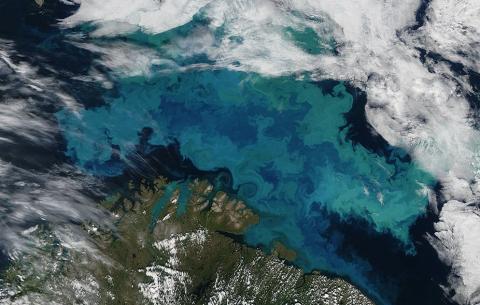
What ocean color reveals about climate change
A team of American researchers from the Massachusetts Institute of Technology (MIT) has just shown that ocean color revealed by satellite could be used as a sign of climate change.
Everyone knows those images of swirling blues and greens that adorn the world's oceans as seen from the sky. These amazing shapes and colors are due to the presence of billions of microscopic plants, grouped under the name of phytoplankton. The activity of these organisms varies according to the environmental conditions: sunshine, temperature, currents...with a direct impact on their appearance seen from the sky.
We will see here how researchers relate this activity to climate change.
Phytoplankton, a powerful source of oxygen
The oceans are populated by organisms that drift with the currents and form what is known as marine plankton. Like land plants, some of these organisms carry out photosynthesis: thanks to light energy, they are able to transform inorganic carbon (and in particular carbon dioxide, CO2, present in the atmosphere) into organic matter and oxygen.
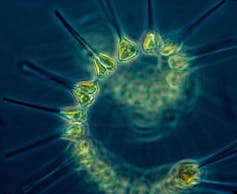
NOAA MESA Project, CC BY-NC-ND
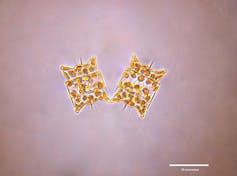
Richard A. Ingebrigtsen, CC BY-NC-ND
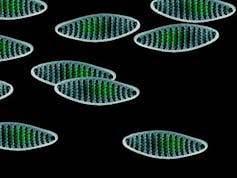
Above, three diatoms belonging to the marine phytoplankton: Asterionellopsis glacialis, Odontella aurita and Fragilariopsis kerguelensis. Their colors represent key information for researchers.
Uwe Kils, CC BY-NC-ND
This "plant" plankton, or phytoplankton, is responsible for the production of almost half of the oxygen we breathe. It thus plays a central role in the flow of carbon on a global scale, and consequently in the regulation of our planet's climate. Its other major role is of course to supply food to all marine food networks and fisheries.
The color of phytoplankton, mainly made up of single-celled microalgae, reflects its pigment content. Thus, a high chlorophyll content gives it a green color, just like that contained in the leaves of land plants.
However, the pigment composition varies from one group of organisms to another. Thus, some are rather brown (like diatoms) while others are rather bluish green (like cyanobacteria) or orange-red (like certain toxic dinoflagellates). Finally, some of them also produce calcified structures (such as coccolithophores, at the origin of calcareous deposits) which gives them a whitish color.
Phytoplancton tracked by satellite

One way to study the dynamics of marine phytoplankton on a large scale is by using satellites that rotate around the earth, measuring the proportion of light that the ocean surface reflects back to space, called reflectance. Seen from space, our planet appears blue because it is 70 percent covered by water, and water molecules tend to absorb the red part of the light spectrum and reflect the blue part.
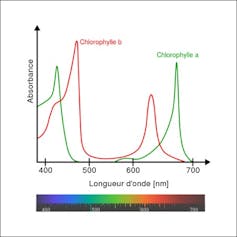
Indeed, the color, whether perceived by the human eye or by a satellite, depends on the wavelengths that make up the light. Thus, microalgae with a high chlorophyll content absorb the blue and orange/red parts of the light spectrum and send back green light that our eyes can perceive. When these microalgae are very abundant, their presence is also visible from space.
Thanks to specific algorithms, ocean color, and in particular the reflectance measured at the ocean surface by satellites, can be used to estimate chlorophyll concentration and to derive estimates of primary production by marine phytoplankton.
Optical properties of the oceans simulated
The MIT researchers, authors of the study, developed a model coupling physics, biogeochemistry and ecology, capable of simulating the physical properties of the ocean (currents, temperature), the fluxes of matter (carbon, oxygen, nutrients), and the dynamics of planktonic communities (including the growth of several types of phytoplankton, such as diatoms, cyanobacteria, or coccolithophores). This model was used to simulate the optical properties of the oceans on a global scale.
By comparing the chlorophyll concentration and reflectance simulated by their model to satellite data from the Ocean Colour Climate Change Initiative (OC-CCI), the team showed that their model was able to correctly simulate the reflectance and water color currently measured at the ocean surface by satellite. These researchers also showed that their model was able to reproduce the variability of the satellite-observed data.

Chlorophyll concentration simulated by the model (top) and observed via satellite by the OC-CCI project (bottom). The simulated mean concentration (left) and variability (standard deviation, right) are very close to the observations. Stephanie Dutkiewicz/MIT, Author provided
3°C higher, phytoplankton deeply impacted
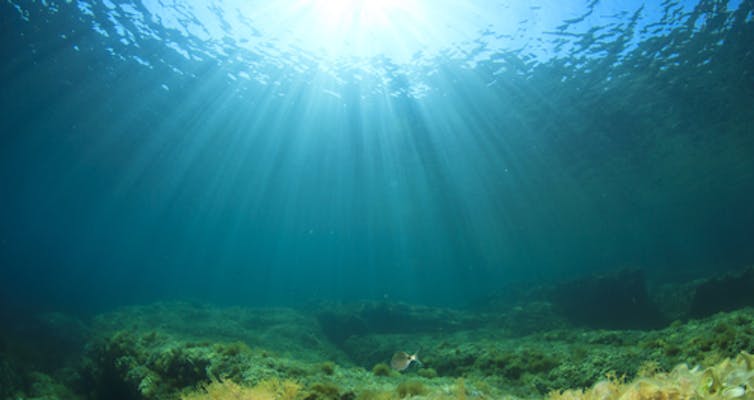
Variations in solar energy entering the ocean cause strong shifts in phytoplankton populations.
Rich Carey/Shutterstock, CC BY-NC-ND
Using their model, these researchers then tested the impact of climate change on the optical properties of the ocean, and in particular on reflectance. For this, they used the RCP8.5 climate scenario of the Intergovernmental Panel on Climate Change (IPCC). This scenario corresponds to the case where greenhouse gas emissions continue to increase along their current trajectory.
It is therefore a pessimistic but realistic scenario. It predicts an average increase of 3°C in ocean surface temperature by 2100, with a decrease in phytoplankton concentration and primary production in most of the world's oceans, but above all, significant changes in these populations.
Indeed, even if the increase in CO2 can favor the growth of phytoplankton in some areas of the globe, the increase in temperature leads to a more "stratified" ocean, with warm waters at the surface that will mix less with the cold waters of the deep, rich in nutrients (unlike the surface). The phytoplankton communities, having less nutrients, will be strongly disturbed.
By estimating the actual color of the ocean by 2100, this study indicates that the color of the ocean will change in response to climate change, and that the strongest signal will be detectable by observing wavelengths in the blue-green part of the light spectrum. This is because the impact of climate change on the phytoplankton communities that inhabit the ocean will be reflected more rapidly in changes in the composition of these communities than in changes in chlorophyll concentration.

Changes in chlorophyll concentration and ocean reflectance simulated by the model. The evolutions are calculated in percentage per year by 2100. A red color indicates a strong increase and a blue color a strong decrease, a white color indicates no change. The model thus predicts strong changes in chlorophyll and reflectance by 2100 in all oceans. Stephanie Dutkiewicz/MIT, Author provided
As a result, the algorithms currently used to estimate ocean chlorophyll from satellite data may not be valid by the end of the century! This work suggests that these algorithms will have to be continuously updated and calibrated from field data, but also that algorithms that take into account chlorophyll, particle content, and dissolved organic matter at the ocean surface, would be the most efficient.
A first study that opens new avenues
Although these results are mainly based on models, which, by definition, only represent a simplified version of reality, they are corroborated by current observations. This study is thus the first to study the impact of climate change on the optical properties of the oceans on a global scale, taking into account the dynamics of marine phytoplankton communities.
It also identifies several areas of interest for observing the response of the oceans and marine plankton to climate change, both through the maintenance and improvement of satellite observation methods of ocean color, and through long-term observation of plankton communities in situ.
Links in French:
Sakina-Dorothée Ayata, Associate professor in Marine Ecology, Sorbonne University
This article is republished from The Conversation under a Creative Commons license. Read the original article.
